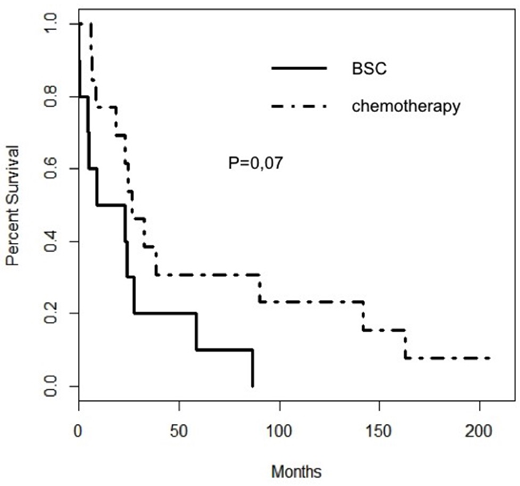Abstract
Introduction
Although the median age at diagnosis of acute myeloid leukemia (AML) is 67 years, with approximately one third of patients aged 75 years or older, limited treatment options are available for the elderly. There is no standard of care for older patients with AML unfit for intensive chemotherapy. In this case, despite specific treatment such as low-dose cytarabine (LDA) and 5 azacytidine (5AZA), outcome remains extremely poor, without cure (Thomas X, Current Treat Options Oncol 2017, 18(1):2). The goal of our study is to establish a prognostic model of survival in order to identify whether the absence of specific treatment may not be harmful in a subset of patients.
Patients and Methods
The French Hauts-de-France AML observatory is a population-based database reporting AML cases diagnosed and supported in 9 Hospital Centers from the French region Haut-de-France. From January 2008 to December 2016, 572 patients older than 75 years were included in the observatory. Among them 324 patients received best supportive care (BSC) alone, 142 hypomethylating agents, 82 low doses aracytine, and 24 other treatments. As a general consensus accepted in all participating centers, BSC was proposed in unfit patients, after performance status and comprehensive geriatric assessment according to results of a preliminary fast geriatric assessment oncodage G8 (Bellera CA, Ann Oncol 2012, 23(8):2166-72). Clinical data were collected in each center. The study was conducted according to the Declaration of Helsinki and was approved by the Human Research Committee of Lille and the internal review board of the Lille University Hospital Tumor Bank (certification NF 96900-2014/65453-1).
Results
In the BSC group, median age at diagnosis was 82 years (interquartile range [IQR] 78-86). Median WBC count was 7.3 x10^3/mL (IQR 2.18-42.5) with a median peripheral blood blasts percentage of 21% (IQR 6-59.5). Median bone marrow blasts was 51% (IQR 30-75). Karyotype was available for 181 patients. Two patients were in the favorable, 111 patients (61%) were in the intermediate, 68 patients (38%) were in the unfavorable cytogenetics group and 58 patients (32%) had a complex karyotype.
For the BSC group, median survival was 3.2 months (IC 2.3- 4) with a 18% 12-months survival estimate.
In univariate Cox models, WBC count (p<0.0001), circulating blasts percentage (P=0.0001), bone marrow blasts percentage (P=0.0001) and complex karyotype (p= 0.05) were predictive of a shorter survival. Neither age nor unfavorable karyotype retained prognostic value.
Multivariate analysis selected two independent covariates namely circulating blasts percentage without identifiable cutoff (p=0.0002), and complex karyotype (p=0.05). Prediction of risk according to this proportional hazard model showed that patients at lowest risk could be defined by the absence of both complex karyotype and circulating blasts. The survival of this subgroup of unfit patients who received BSC (7% of patients, median 16 months) was not significantly different from the survival of fit patients with the same characteristics (absence of both complex karyotype and circulating blast) who received 5AZA or LDA (median survival of 26.6 months, p=0.07) (Figure 1.).
Remaining patients (with complex karyotype or circulating blast), of the BSC cohort had a shorter survival than patients treated with 5AZA or LDA (3.7 months vs 13 months, p<0.0001).
Conclusion
In a population of elderly AML patients (> 75 years), 18% are alive at 12 months without any chemotherapy. Our results indicate that the absence of chemotherapy may not be detrimental in a small subset of unfit patients identified by the absence of both complex karyotype and circulating blasts. However further studies are mandatory for characterizing most of patients alive at 12 months with BSC.
Figure 1. Survival of patients with both complex karyotype and circulating blasts
No relevant conflicts of interest to declare.
Author notes
Asterisk with author names denotes non-ASH members.


This feature is available to Subscribers Only
Sign In or Create an Account Close Modal